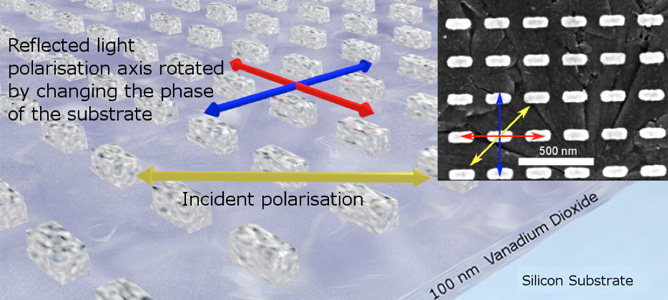Twisting light for faster internet

Diagram of the polarisation rotation device. Inset: SEM image of silver nanorods on vanadium dioxide-coated silicon substrate.
March 2015
With the advent of fibre optic networks the bandwidth of the internet increased dramatically. The bottlenecks to next-generation internet speeds are now the points at which the light carrying the signal is switched to an electronic signal.
By replacing current electronic switches with optical equivalents, these bottlenecks can be removed increasing throughput while reducing power consumption, waste, heat and maintenance costs.
A collaborative project between researchers at the University of Melbourne, MCN, CSIRO and Vanderbilt University has created a device which enables the user to rotate the reflected linear polarisation axis of light. Used in conjunction with a pair of linear polarisers this allows a passive routing of the reflected signal. The working is a phenomenon known as a localised surface plasmon (LSP), which is caused by resonant oscillations of the free electrons confined to a metallic structure smaller than the wavelength of light. An array of rods, each displaying two of these LSPs parallel to their two axes, permits altering the polarisation state of that light. By carefully setting the dimensions of the rods, it is then possible to use these LSPs in conjunction with a phase change material to rotate the reflected light’s polarisation axis. Dramatically increased optical switching is relevant for a range of optical devices from microprocessors and electronics to sensing and telecommunications.
Electron beam lithography and evaporation of ultra-thin silver films were used at MCN to create optical antennas on vanadium dioxide, a phase change material deposited by collaborators at Vanderbilt University. Atomic force microscopy and scanning electron microscopy was then used to characterise the vanadium dioxide film and image the antenna arrays. The facilities at the MCN enabled the refinement of the fabrication process and creation of the actual device.
This project has shown how a simple structure can twist the polarisation of reflected light. In principle this could be further developed such that its operation is ultra-fast. While the crystalline phase of vanadium dioxide was transitioned thermally, it has the potential to be switched optically on a sub-picosecond timescale, enabling switching orders of magnitude faster than current technology.
The device has been shown to work in the visible part of the spectrum, however moving the design to telecommunications wavelengths (near infrared, 1550 nm) will facilitate device longevity by enabling the use of gold rather than silver, as well as simple integration into current fibre optic networks. Long-term plans aim to implement a simple self-switching design using amplitude modulation of the incident signal.


